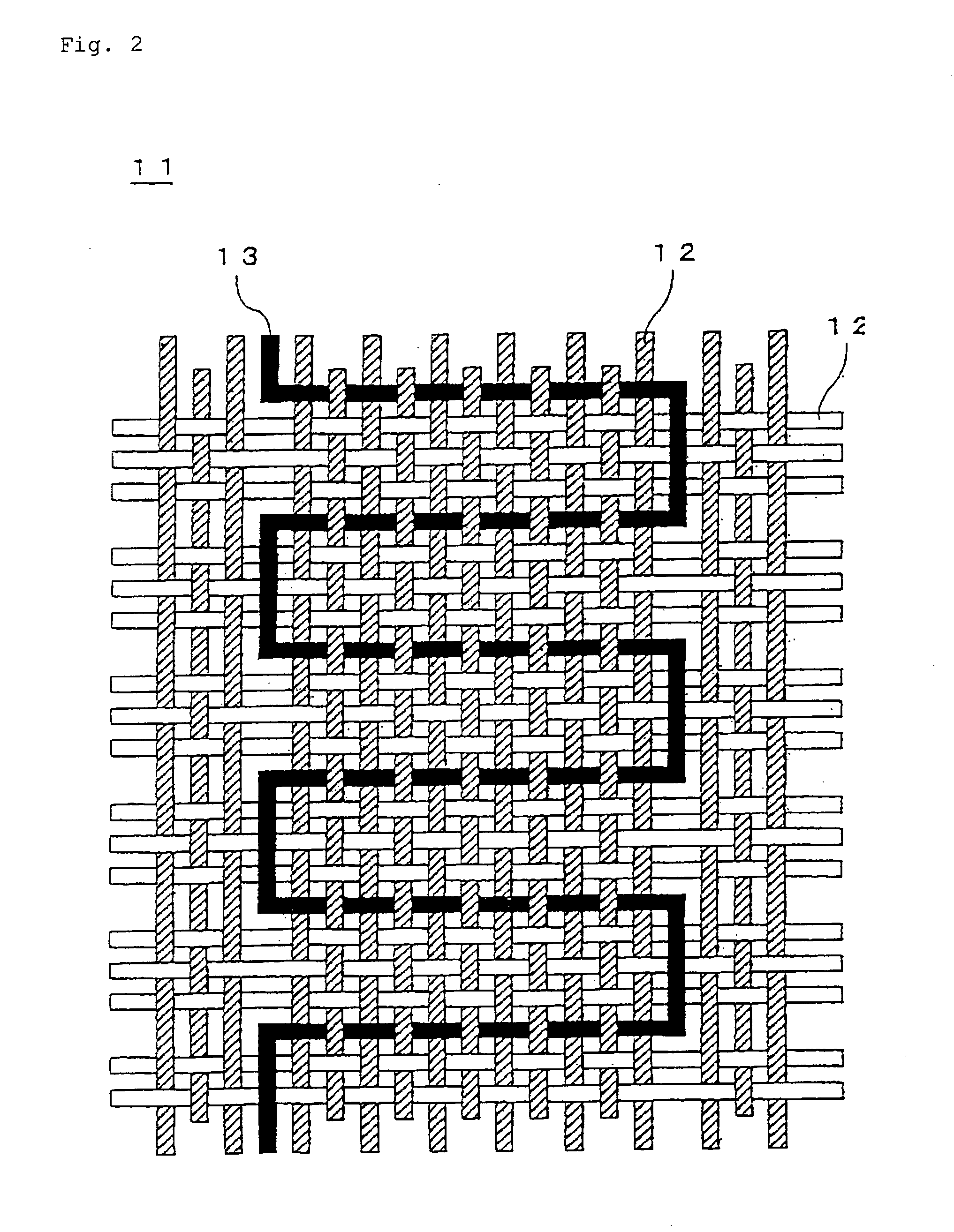Woven or knitted fabric, diaphragm for speaker, and speaker
a diaphragm and fabric technology, applied in the direction of ceramic diaphragms, knitting, ornamental textile articles, etc., can solve the problem of elevated production costs, achieve excellent flexibility and bending properties, and produce at a low production cos
- Summary
- Abstract
- Description
- Claims
- Application Information
AI Technical Summary
Benefits of technology
Problems solved by technology
Method used
Image
Examples
example 1
[0116] Parallel yarns each made of two polyester multifilaments with 33.3 dtex / 36 f (s900 (downward twisting) / z 600 (upward twisting)) were used as a warp and on the other hand, polyester multifilaments with 83.3 dtex / 72 f and a core-sheath structure fused yarn (83.3 dtex / 24 f) obtained by conjugating a polyester fiber having a melting point of 230° C. as a core material with a modified polyester having a melting point of 180° C. as a sheath material to form a thermally fusible layer on the surface of the core material were used as the weft at 1:1 and further as a portion of the weft, two parallel copper wires coated with a polyester and having a diameter of 0.1 mmφ were used and accordingly, a twill fabric in which a coil-like shape shown in FIG. 2 and FIG. 9 was formed was woven as a substrate. The piling number was 130 / 2.54 cm for the warp and 90 / 2.54 cm for the weft.
[0117] While being pinched from the upper side and the lower side by a clump with a disk shape having a hole with...
example 2
[0118] A woven fabric was produced in the same manner as Example 1, except that parallel yarns each made of two polyester multifilaments with 83.3 dtex / 72 f (s900 (downward twisting) / z 600 (upward twisting)) were used as a warp and polyester multifilaments with 83.3 dtex / 72 f (s300) and a core-sheath structure fused yarn (83.3 dtex / 24 f) obtained by conjugating a polyester fiber having a melting point of 230° C. as a core material with a modified polyester having a melting point of 180° C. as a sheath material to form a thermally fusible layer on the surface of the core material were used as the weft at 1:1 and further as a portion of the weft, two parallel copper wires coated with a polyester and having a diameter of 0.1 mmφ were used. The piling number was 166 / 2.54 cm for the warp and 90 / 2.54 cm for the weft. Weight of the twill fabric was 175 g / m2.
example 3
[0119] A woven fabric was produced in the same manner as Example 1, except that parallel yarns each made of two polyester multifilaments with 83.3 dtex / 72 f (s 900 (downward twisting) / z 600 (upward twisting)) were used as a warp and polyester multifilaments with 83.3 dtex / 72 f (s300) were used as the weft and further as a portion of the weft, two parallel copper wires coated with a polyester and having a diameter of 0.1 mmφ were used. The piling number was 166 / 2.54 cm for the warp and 90 / 2.54 cm for the weft. Weight of the twill fabric was 175 g / m2.
PUM
| Property | Measurement | Unit |
|---|---|---|
| Electrical conductor | aaaaa | aaaaa |
Abstract
Description
Claims
Application Information
 Login to View More
Login to View More - R&D
- Intellectual Property
- Life Sciences
- Materials
- Tech Scout
- Unparalleled Data Quality
- Higher Quality Content
- 60% Fewer Hallucinations
Browse by: Latest US Patents, China's latest patents, Technical Efficacy Thesaurus, Application Domain, Technology Topic, Popular Technical Reports.
© 2025 PatSnap. All rights reserved.Legal|Privacy policy|Modern Slavery Act Transparency Statement|Sitemap|About US| Contact US: help@patsnap.com



